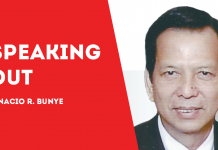
WHEN I was working for government, there were a few calamities, even armed conflict, causing devastation on lives and livelihood. Disaster relief and rehabilitation became everyone’s job. And that meant —
One, coordination with local authorities. Provincial, city, municipal, and barangay officials had the data. They knew the immediate needs of their residents and the challenges in terms of resources and infrastructure. They had the physical body — the tanods, drivers, cooks, and social workers — and, along with our uniformed men and women, the skills and training for executing emergency response. There was no reason to compete with them.
Two, deployment of teams on the ground. The purpose was not to advertise like a PR strategy but to assess the situation. For example, additional help might no longer be necessary, and with that feedback other areas could then be prioritized. Early assessment could also identify potentials for rehabilitation, beginning the much longer process of recovery. In Marawi, that initial deployment became just one of many, translating to temporary housing shelters and livelihood projects for the families that had been displaced by the siege.
Three, accountability. Teams documented the distribution of relief goods, working within the reality of a calamity, the urgency and chaos of it all. Such a task instilled a mindset that cares about public funds and donations beyond mere compliance with regulations.
Four, communications. They say pictures paint a thousand words, but in times of calamity, numbers offer something more concrete. Regular reports on social media showed the amounts allocated, collected, and spent, areas and number of families reached, and types of assistance provided. Compared to mere photographs of government officials collecting and distributing relief good, this approach on transparency created public trust.
Five, collaboration with the private sector. It allowed quick and multi-sectoral response without abdicating the job of government. It also offered opportunities for civic-minded people to share, lead, and empower.
Six, procurement planning and implementation. Historical data, market studies, and analysis were important; the willpower to make things move even so. The bureaucracy sometimes gets the flak for being either unresponsive or unscrupulous; but with professionalism, responsive relief efforts can become second nature.
And last, empathy.
Helping can become a routine, a monotonous act that neither sees nor feels. Although there’s nothing wrong with a well-programmed machine — efficiency often equates to success — without the human factor, public service might feel like a burden not just to the recipient but to the public servant too.
At the same time, helping can appear self-centered when every act of generosity is plastered on tarps and social media posts. Helping can appear patronizing when the focus is on the giving without room for connecting and dignity. And helping can lull the citizenry into parading resiliency with such pride that government can bungle its job without fear of liability.
That’s why our boss, former Vice President Leni Robredo, practiced empathy and said:
“Empathy is much different from sympathy. Sympathy is an emotional response to what you hear; empathy is an active response to what you feel … it can only be learned when we immerse ourselves in the difficulties being faced by the people we want to serve.”
As a private citizen, she reiterated this concept of “solidarity”:
“This is the only way we can truly meet the needs of the people we serve — by reaching out to them, putting ourselves in their very shoes, and holding ourselves accountable for the suffering they are going through.”
I don’t think we — government and the public alike — would have been completely moved to action back then without this “spiritual muscle” of empathy. Those actions continue, as it ought to, for the sake of the people who have entrusted their power to a chosen few./PN







